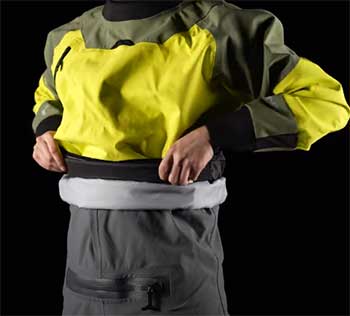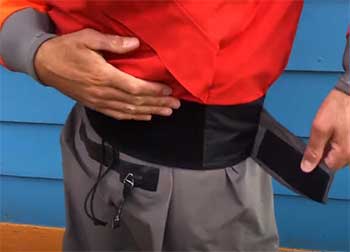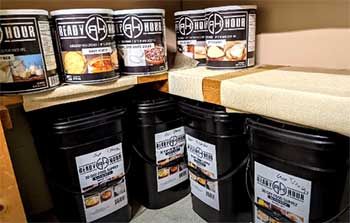Kayaking is the most exciting water sport. Nothing compares to the thrill of plunging into the water with a paddle. And for kayaking, a drysuit is a fantastic invention that might even save a life by keeping you dry and warm in ice-cold water.
As a drysuit is not really cheap, you should be careful and take the time to research before investing in it. NRS and Kokatat are the two most popular brands for dry suits, and you might’ve already heard about them.
But which one should you choose? In this article, I’ll walk you through this.
A Quick Comparison Table
| Specifications | NRS Drysuit | Kokatat Drysuit |
| Entry style | Rear Zip | Front Zip |
| Material | 3-layer GORE-TEX® Pro, Neoprene | 3-layer GORE-TEX® Pro, Latex |
| Latex Neck and Wrist Gaskets | No | Yes |
| Weight | 2.24 lbs | 3.94 lbs |
| Pockets | 1 Kangaroo, 2 Sleeve | 1 Thigh, 2 Sleeve |
In-Depth Differences Between NRS And Kokatat Drysuit
Now it’s time to analyze the major differentiations between these two drysuits in detail:
- Company Overview

It’s important to choose the right company while buying a drysuit because the company’s reputation and history matter a lot to some extent.
In 1971, Kokatat started producing garments and equipment for paddle sports.
This company understood that local production was essential to maintain quality and continuously created the best and driest paddling apparel in the world.
On the other hand, since 1977, NRS has been producing strong, dependable gear for their passionate clients, seasoned outfitters, and guides.
So comparing the two companies, both have their own reputation and glorious history.
Also Read: Differences Between Hoodoo And Hobie Kayaks.
- Drysuit Type
Drysuits with a front zip or a rear zip offer both advantages and disadvantages. Since drysuits aren’t cheap, it’s a good idea to understand the variations before purchasing.
To assist you in determining which is best for you, here’s a detailed comparison.
Kokatat drysuits with a front entry have a zipper that extends across the chest from the upper right shoulder to the left side of the waist.
The primary benefit of front entrance suits is that the kayaker finds it much simpler to put on and fasten the dry suit by themself. It is a straightforward, tested method that has been used for more than 30 years.
It is also simple to visually verify that the suit is fully “zipped” up.
The biggest disadvantage of the front zip drysuits is they frequently bunch up under your PFD (personal flotation device), giving you the impression that you are being constricted.
NRS dry suits with a rear zipper have the entry zipper running between the shoulders from the chest to the back. It avoids the spray skirt tunnel, making it a popular option among whitewater kayakers. The rear zip drysuits have the advantage of preventing bunching under your PFD. And, if your shoulders are flexible, they are simple to put on and take off.
- Material
Drysuits are comprised of fabrics that are waterproof and breathable. Gore-Tex and nylon are the most common material used in the body of drysuits.
However, numerous manufacturers have developed unique laminate materials that function nearly as well as Gore-Tex while being a little more cost-effective when used to create dry suits for kayaking.
Here, both NRS and Kokatat drysuits are made of Gore-tex. But some parts of the NRS drysuits are made of neoprene, whereas Kokatat uses latex for those parts.
Gore-Tex is a premium laminate fabric made of expanded polytetrafluoroethylene, or ePTFE, which is extremely durable.
Since it has a higher level of breathability than other fabrics, it is only used to create high-end kayaking drysuits. No other material comes close to Gore-Tex in terms of breathability and durability.
Neoprene maintains its elasticity over a broad temperature range and demonstrates strong chemical stability.
On the other hand, latex is made entirely of natural rubber from the Helvetica Brasilius tree. For the neck gasket and neck closure of the drysuit, neoprene is more comfortable than latex.
- Additional Features
The greatest kayaking drysuits come with a ton of added features that improve their usability, comfort, safety, and functionality.

Although not all of them are strictly necessary, they frequently distinguish between “excellent” and “great.”
Kokatat Drysuit has additional features like – improved GORE-TEX PRO material, using 47.2% less water and 1.6% less carbon, a stowable hood made of GORE-TEX Paclite, removable suspenders, a Limited Lifetime Warranty, bungee waists, nylon zippers, etc.
NRS also has some extra features but not as many as Kokatat.
An extra layer of EclipseLT on the legs, YKK and AquaSeal relief zippers, and waterproof entry are some unique features of NRS.
But the main advantage of NRS is it’s lightweight(only 2.24 Ibs). Its price is also lower than Kokatat’s.
So if you want a light drysuit as well as want to save some bucks, choose NRS. But for the fancy features, you should go for a Kokatat drysuit.
Also Read: Differences Between Werner And Aqua-Bound Kayak Paddles.
Frequently Asked Questions (FAQ)
Yes. Kokatat was the first company to create a functional waterproof/breathable dry suit or dry top, and Kokatat continues to provide the best and excellent quality products in this category.
The Kokatat PFDS are made in Arcata, California.
The Kokatat drysuit is the best for paddle sports enthusiasts because it was specially created with kayakers in mind and has a number of great features.
The Gore-tex Pro shell breathable lining of the Kokatat helps to soak moisture away from the skin, keeping you dry even while you’re paddling vigorously.
Even if you wear your kayak drysuit throughout the year, they will last at least 10 to 15 years.
Final Words
Purchasing a drysuit for kayaking is more difficult than you think. The kind of entry you require, the material you should use, and the climate you’ll be using it in can all have an impact on the drysuit model you need.
A full-body drysuit can literally save your life in frigid seas. Drysuits can surely make your kayaking excursion a lot more comfortable, even on days when the weather isn’t so bad.
I hope the comparison of NRS and Kokatat drysuits can help you to choose the right drysuit and settle your dilemma.
Happy kayaking!

